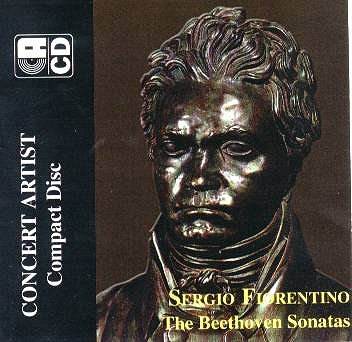The fourth of Sergio Fiorentino’s six volume part-complete
Beethoven cycle covers Nos. 26-30, that is, Opp. 81a (Les Adieux),
90, 101 and 109. It thus takes him to the last Sonatas but like
Solomon slightly before him the cycle was never to be completed. Concert
Artist/Fidelio have, at last counting, issued about seventeen sonatas
and they demonstrate his commanding profile in the works, unfettered
by gimmick or caprice, only occasionally lessening the rhythmic plasticity
that so much informs his best playing.
Fiorentino gives judicious weight to the leave-taking
of the E flat, the skipping runs of the Allegro section splendidly executed
and characterised. He alludes to but doesn’t overstress those little
troubling insistencies of line here. One thing remaining true about
Fiorentino, no matter what the debate surrounding him, is his sustaining
of a slow tempo; here he vests the Abwesenheit with a certain
questing nobility and similarly in the Wiedersehen his elative
freedom comes always with fluent flexibility, well contoured pedalling,
not over fleet and with plenty of architecturally cogent room at the
conclusion for a moment of generously grateful reflection. The little
two-movement E minor is taken at a good tempo, the first movement enshrined
in Fiorentino’s hands with incipient melancholy and the final movement
summoning up reserves of colour and tonal purity in moments of almost
Schubertian cantabile. His approach to Op. 101 is similarly convincing,
Fiorentino preserving a flowing tempo for the opening movement imbued
with romanticism and is rhythmically alive to the march of the second.
In the final movement, which he takes quite slowly, he evokes a spirit
of radiance, his articulation of optimum clarity, and the manner in
which he deals with the fugato development impressive. His tone never
coarsens or hardens, certainly never becomes brittle, no matter what
the digital provocation; he is rousing but not artificially so; excitement
is generated from the body of the text, not imposed artificially from
without. In Op. 109 his opening Vivace is controlled, lyrical and affectionate.
The Prestissimo shows Fiorentino’s adherence to Beethoven’s indications
– once again clarity is never at the expense of drama and his technical
command of the double counterpoint is not in question. The finale ("Singing
with most fervent feeling") is eloquently expressive, Fiorentino
managing to bind the movement with unselfconscious direction. He isn’t
especially quick in temporal terms; the acuity is architectural.
The engineering has been realised with unobtrusive
excellence and Fiorentino’s tone emerges with unimpaired beauty.
Jonathan Woolf
MusicWeb
can offer the complete Concert
Artist catalogue
